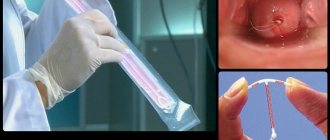The intrauterine device is installed for a period of 3 to 7 years and does not require monitoring by the patient. It is 99% effective, does not affect sex life and is safe during lactation.
Around 50 brands of IUDs are produced worldwide: round, oval and T-shaped, hormonal and non-hormonal, with silver or copper. Some set it for 2-3 years, while other manufacturers claim that their drug can be used for up to 7 years. How to choose the best drug for yourself? Let's figure out how they differ and which device is better.
What is an intrauterine device and how does it work?
Intrauterine devices are contraceptives, a means of controlling the onset of pregnancy.
Their effectiveness is very high: when used correctly, they protect Birth Control Methods: How Well Do They Work? from pregnancy by 99%. They are even used for emergency contraception after unprotected sex. Externally, most of the spirals that are now used resemble the letter T with different tails. But there are intrauterine implants of other forms.
Spirals are divided into two large types:
Copper intrauterine device
healthinfi.com
The principle of operation is this: copper supports aseptic inflammation in the uterus. Aseptic means that it does not happen due to microbes and does not threaten anything. But the action of copper changes the composition of cervical mucus, making it more difficult for sperm to penetrate the uterine cavity. In addition, copper prevents the egg from attaching to the wall of the uterus Intrauterine device (IUD).
Intrauterine device with a hormonal component
healthtalk.org
These are plastic coils that contain progesterone, an analogue of the human hormone that prevents pregnancy.
They also interfere with sperm and egg implantation, and at the same time also suppress ovulation in some women Intrauterine system (IUS).
Indications and contraindications
It is better to use intrauterine contraception:
- for patients who have already given birth after an abortion, if there is no inflammation of the pelvic organs;
- giving birth to women aged 35+ who refused to take oral contraceptives due to any of their shortcomings;
- women with a low risk of STIs who have a regular sexual partner.
Before installation, you need to study contraindications to the IUD. Otherwise, it may cause serious harm to health.
It is better not to use an intrauterine device in the following cases:
- infectious and inflammatory processes of the genital organs;
- allergic reactions to metal or a hormonal drug in the IUD;
- suspicion of pregnancy;
- vaginal bleeding under unclear circumstances;
- oncology or benign tumors of the genitals;
- anomalies in the structure of the female reproductive organs;
- chronic diseases of the pelvic organs;
- erosion of the uterine cervix.
Having studied which type of intrauterine contraception is best, you need to undergo a thorough examination by a doctor before installing an IUD. This will help eliminate any contraindications, disadvantages of intrauterine contraception and reduce the risk of causing any harm to health.
How to install a spiral
Only a doctor can install any type of spiral, and the same can remove it. Therefore, you cannot do without consulting a specialist who will help you choose a product (with copper or hormones) and decide on the installation.
This is usually a simple procedure, but an extremely rare complication is uterine perforation INTRAUTERINE DEVICES. Sometimes the spiral may fall out. Therefore, in the first three months you need to regularly visit the gynecologist; the doctor himself will prescribe a schedule.
fancy.tapis.gmail.com/Depositphotos.com
After installation, the spiral is not felt, only two short antennae are released from the cervical canal (from the cervix). These are Intrauterine Device (IUD) threads that help make sure the IUD is in place. Subsequently, they will help the gynecologist remove the IUD.
These same mustaches do not interfere in everyday life, including during sex.
Sometimes after installation a woman may feel discomfort and dizziness, but they pass quite quickly. The procedure itself is not very pleasant, but not much worse than a regular examination by a gynecologist.
Rules after the introduction of the IUD
Those using intrauterine devices must adhere to the following rules:
- Sexual activity can begin after the procedure in 7-10 days.
- Visiting the bathhouse and sauna is allowed after 14 days.
- It is advisable to avoid strenuous physical activity.
- Periodically check the length of the spiral threads.
- Visit a gynecologist 2 times a year.
- It is strictly forbidden to remove the spiral yourself.
- In the first days after administration, pain is possible; you are allowed to take a painkiller tablet.
- For several months after installation, painful and heavy menstrual flow is possible.
The intrauterine device is one of the safest and most reliable methods of contraception. If necessary, you can remove it at any time and immediately begin conceiving a child.
If you find an error, please select a piece of text and press Ctrl+Enter
What are the advantages of an intrauterine device?
The main advantage is the reliability of contraception. Nothing here depends on the woman, her partner or a host of external factors. Condoms break, you can forget about the pill, but the coil stays in place and doesn’t go away.
In addition, the IUD can be used by breastfeeding women who cannot afford, for example, hormonal contraceptives.
In most cases, women do not notice the spiral at all.
Contrary to popular belief, the IUD can be installed in women who have never given birth or become pregnant before (but it is better to use the IUD after 20 years, when the internal organs are fully formed). IUDs have a reversible effect, and you can get pregnant literally in the first month after removing the IUD.
In addition, IUDs do not increase the risk of cancer and can be combined with any medications Your contraception guide.
Possible consequences
Possible consequences and complications after installing a female contraceptive:
- injuries during the equipment installation procedure, development of bleeding;
- spiral loss;
- menstrual irregularities;
- pregnancy, which usually ends in surgical abortion;
- development of chronic inflammatory processes after removal of the contraceptive and during use of the device;
- unsuccessful attempts to remove the device, ending with surgical curettage of the uterine epithelium;
- infertility.
The IUD cannot be installed if there is inflammation in the uterus.
Relative contraindications to insertion of an IUD:
- history of chronic inflammatory processes of the reproductive system;
- a history of ectopic pregnancy;
- menstrual irregularities, heavy menstruation;
- malformations of the uterus;
- endometriosis;
- inflammatory processes in other organs;
- spontaneous loss of a contraceptive in the past;
- narrowing of the cervical canal;
- fibroids;
- diseases of the cardiovascular system, blood.
When should you not insert an intrauterine device?
There are not many contraindications for Birth Control and the IUD (Intrauterine Device):
- Pregnancy. If you want to use the IUD as emergency contraception, you need to hurry.
- Infectious diseases of the pelvic organs (including sexually transmitted diseases or those associated with complications after termination of pregnancy). That is, we first treat infections, then introduce the IUD.
- Oncological diseases of the uterus or cervix.
- Vaginal bleeding of unknown origin.
- There are additional restrictions for the IUD with hormones, just like for taking hormonal contraceptives.
Review of popular types of IUDs - which model is better?
Below is a rating of the best types of intrauterine devices according to reviews from doctors and patients. Before purchasing, consult your gynecologist. Of all the types of intrauterine devices, only the doctor decides which is best for each patient after a thorough examination.
| Model | Design Features | Advantages | Flaws | Validity |
| Goldlily Exclusive | T-shaped spiral with a leg wrapped in copper and gold bimetallic wire | Anti-inflammatory effect, suitable for women with metal allergies, does not affect hormonal levels, long-term protection against pregnancy, low risk of expulsion | Contraindications: oncology, any infectious and inflammatory processes of the pelvic organs, pathologies of the uterus | 7 years |
| Nova T | T-shaped spiral, contains polypropylene, copper and silver | Painless installation, long-term protection against pregnancy, does not affect hormonal levels, can be installed during the postpartum period | Contraindicated for allergies to metals, cervical dysplasia, oncology, infectious and inflammatory diseases of the genital organs | 5 years |
| Multiload Cu-375 | F-shaped spiral with a leg wrapped in copper wire | Reliable fixation in the uterine cavity, does not affect hormonal levels, can be placed in the postpartum period, suitable for nulliparous women | Risk of allergic reactions, increased heaviness/duration of menstrual bleeding | 4-5 years |
| Juno Juno Gold | T-shaped spiral with a leg wrapped in bimetallic gold and copper wire | Long-term protection against pregnancy, anti-inflammatory properties, hypoallergenic, does not affect hormonal levels | Contraindications: endometriosis, cancer, inflammation of the genital organs, abnormal development of the uterus | 9 years |
| "Mirena" | T-shaped coil containing levonorgestrel in the core | Reducing the volume/duration of menstruation, suitable for women with endometriosis or fibroids, can be used for hormone replacement therapy | High price, possible intermenstrual bleeding, decreased libido, amenorrhea, dizziness, headaches | 5 years |
| Copper TCu 380A | T-shaped spiral, contains polypropylene and copper | Low price, long duration, does not affect hormonal levels, allowed for patients with inflammation of the appendages, ovarian dysfunction | Not suitable for women with copper intolerance, cancer, endometriosis, chronic inflammation of the pelvic organs | 10 years |
What side effects may there be
Apart from complications when installing the IUD, the most common side effect is changes in the menstrual cycle. As a rule, periods become heavier and last longer. This is especially noticeable in the first months after the installation of the spirals.
Sometimes bleeding becomes too heavy and long, bleeding appears between cycles - in any case, this should be discussed with your doctor. Sometimes you have to abandon this method of contraception.
IUDs do not protect against sexually transmitted infections, and in some cases increase the risk of an ascending genital tract infection. Therefore, with a new partner you need to use additional methods of contraception.
What complications can there be when installing a spiral?
In rare cases, women with an intrauterine device may experience some complications:
- More heavy and painful periods. If menstrual flow is observed in large volumes, it is recommended to remove the IUD, since such menstruation can provoke the development of anemia.
- Sometimes the coils become dislodged and can cause pain or discomfort, especially during sexual intercourse. In these cases, you need to consult a doctor as soon as possible to correct the position of the IUD, otherwise there is a possibility of developing an inflammatory process in the uterus.
- Intermenstrual vaginal discharge may appear, and its smell may be unusual.
- If a woman has had sexual contact with a man who has an STI, the IUD will not protect against infection.
- There is a small risk of an ectopic pregnancy. This probability is especially high in women who have a history of pathological pregnancy development.
- With an IUD installed, the endometrium gradually becomes thinner. For this reason, there is a risk of miscarriage in the future, so it is better not to insert the IUD into women who do not yet have children.
The fact that you need to periodically monitor the presence of spiral threads in the vagina and the unchanged position of them may alert a woman. But this is necessary for timely detection of IUD displacement, which can cause some complications. If the threads become shorter or, conversely, longer, you need to consult a doctor. Most likely, the IUD has moved from its place.
In more rare cases, when there were factors such as installation of the IUD by an inexperienced specialist, the presence of undiagnosed diseases, individual characteristics of the body, etc., more severe complications may develop:
- inflammatory process in the uterus or pelvic organs;
- perforation of the organ during installation of the IUD;
- development of endometriosis;
- infection during installation of the coil;
- infertility.
- But in the vast majority of cases, such complications can be avoided if the installation of the spiral is carried out by a qualified specialist.
Possible consequences
Possible consequences and complications after installing a female contraceptive:
- injuries during the equipment installation procedure, development of bleeding;
- spiral loss;
- menstrual irregularities;
- pregnancy, which usually ends in surgical abortion;
- development of chronic inflammatory processes after removal of the contraceptive and during use of the device;
- unsuccessful attempts to remove the device, ending with surgical curettage of the uterine epithelium;
- infertility.
If the IUD is removed incorrectly, curettage of the uterus may be necessary.
Structure and features
The hormonal IUD for women is reliable protection against unwanted conception. This device consists of:
- horizontal flexible hangers;
- hormone-containing cylinder;
- threads for extracting the spiral.
It should also be noted that, like regular IUDs, hormonal devices are installed only by a gynecologist. In this case, the specialist must immediately warn that such a device can be worn for no more than five years.
Reviews
Marina
I myself have not installed such devices, but my colleague regularly does. She currently has Mirena due to endometriosis. The periods are coming drop by drop. But overall she is happy.
Anna
I have a negative experience - an ectopic pregnancy. Now I live with one pipe. I protected myself on my own!
Lavender
The spiral itself stood and worked. But when the time came to take it out, I had to clean it. The doctor couldn’t do anything – neither with a crochet hook nor with other tools. I won't put it on again.
Mode of application
The product in question is used as follows:
- For contraception for women (of childbearing age), the IUD is installed within a week from the start of menstruation. Moreover, it can be replaced with a new intrauterine device on any day of the cycle. This device can also be installed immediately after an abortion in the first trimester of pregnancy.
- In order to protect the endometrium during estrogen replacement therapy in patients with amenorrhea, the IUD can be inserted at any time. As for women with preserved menstruation, the installation is performed on them in the last days of menstrual bleeding.
- After childbirth, the IUD is introduced only after uterine involution occurs, but not earlier than 6 weeks. With prolonged subinvolution, postpartum endometritis should be excluded, and the decision to install the structure should be postponed (until the involution is completed). If insertion is difficult or there is very severe pain or bleeding before and after the procedure, it is necessary to perform an ultrasound to exclude perforation.
The likelihood of pregnancy while using the IUD
Protection against pregnancy does not always work. The IUD only provides a guarantee 97% of the time. According to statistics, 1% of women who choose the intrauterine method of contraception become pregnant with an IUD.
Conception occurs due to unsuccessful installation or displacement of the device's shoulders.
Special Recommendations
The design of the Levonov intrauterine device ensures the release of the hormone at a rate of 20 mcg/day. The validity period of this device is 5 years. After its removal, the woman’s reproductive function is restored quickly and well.
This product should not be used during breastfeeding. This is due to the fact that levonorgestrel is able to pass into breast milk. In case of persistent and prolonged intermenstrual bleeding, an additional gynecological examination is required to clarify the diagnosis.
Does the IUD expire?
The contraceptive effect begins immediately after insertion of the intrauterine device and continues as long as it is in the uterine cavity. It is removed at the request of the woman or if complications occur.
The contraceptive effect continues continuously while the IUD is inside the uterus. Its high efficiency can decrease only towards the end of the service period, or when the spiral is displaced. This reduces the reliability of contraception and threatens with unpleasant consequences.
"Levonova"
The Levonov intrauterine device contains 52 mg of levonorgestrel. This is a reliable contraceptive. Its active substance has a direct local effect on the endometrium, reducing its implantation function, as well as on the fallopian tubes and the viscosity of mucus in the cervical canal. Such properties of the device increase the efficiency and duration of use of the IUD without suppressing the ovulation process.
This remedy should be administered on the 4-5th day of the menstrual cycle. If an induced abortion was performed, the IUD is installed immediately or after the next menstruation. For uncomplicated spontaneous childbirth, it is advisable to use a hormonal construct no earlier than six weeks later.
Tablets or spiral?
IUD or hormonal pills - which of these contraceptives to choose? It is quite difficult to answer this question, since each of the presented methods has its own advantages and disadvantages. However, most patients choose the first option. This is due to the following points:
- the reliability and efficiency of the spiral is 99%;
- such a device does not require daily monitoring;
- the use of the spiral is long-term (about 5 years);
- After removal of the IUD, fertility is restored very quickly.
As for oral medications, they are most often not used due to possible weight gain and the development of health problems.
Is it possible to get pregnant with Mirena?
It is believed that any remedy can fail, but not a hormonal IUD. It acts on several processes at once and quite reliably protects against unplanned pregnancy. However, it is possible that the contraceptive effect may be reduced if:
- improper installation of the IUD;
- loss or movement of the IUD in the uterus;
- non-compliance with the wearing period (more than 5 years);
- Mirena is installed after ovulation;
- There was an interval and sexual intercourse between changing the IUD to a new one.








